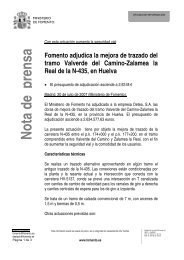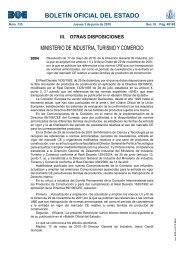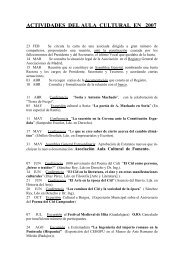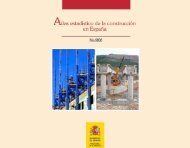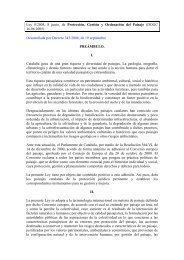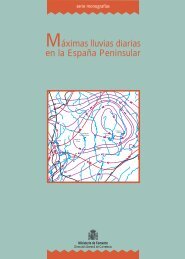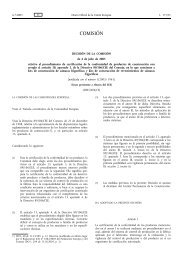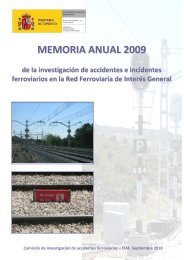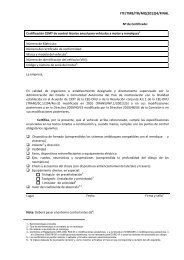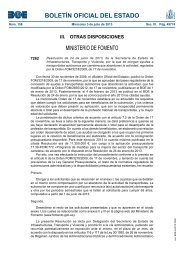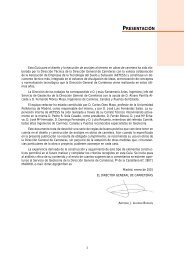atlas of urban vulnerability in spain: methodology and contents
atlas of urban vulnerability in spain: methodology and contents
atlas of urban vulnerability in spain: methodology and contents
Create successful ePaper yourself
Turn your PDF publications into a flip-book with our unique Google optimized e-Paper software.
DOMAIN 4: URBAN VULNERABILITY SYNTHETIC INDEXES (MULTIPLE<br />
CRITERIA CLASSIFICATION)<br />
Multiple Criteria classification <strong>of</strong>fers synthetic Indexes <strong>of</strong> Vulnerability compos<strong>in</strong>g<br />
different simple <strong>vulnerability</strong> <strong>in</strong>dicators, which <strong>in</strong> our case are 20 +1, grouped <strong>in</strong>to four<br />
thematic categories. Multiple Criteria classification is an alternative method to<br />
traditional synthetic Indexes obta<strong>in</strong>ed by the def<strong>in</strong>ition <strong>of</strong> scalar type functions that<br />
comb<strong>in</strong>e the various <strong>in</strong>dicators <strong>of</strong> <strong>vulnerability</strong> by assign<strong>in</strong>g a proportional weight to<br />
each one <strong>of</strong> the <strong>in</strong>dicators 4 .<br />
The existence <strong>in</strong> the Atlas <strong>of</strong> 4 thematic categories <strong>of</strong> <strong>vulnerability</strong> <strong>in</strong>dicators, <strong>of</strong>fers the<br />
possibility to organise 4 thematic classifications for the partial subsets <strong>of</strong> criteria<br />
(Sociodemographic criteria Classification, Socioeconomic criteria Classification,<br />
Hous<strong>in</strong>g criteria Classification <strong>and</strong> Subjective perception criteria Classification) <strong>and</strong> a<br />
Global criteria Classification, encompass<strong>in</strong>g the 20 <strong>in</strong>dicators <strong>of</strong> <strong>vulnerability</strong><br />
considered.<br />
ISVU-SD, Sociodemographic criteria Classification, <strong>in</strong>cludes the set <strong>of</strong> the 5<br />
sociodemographic <strong>in</strong>dicators: (1) Percentage <strong>of</strong> elderly people aged 75 or more,<br />
(2) Percentage <strong>of</strong> households with only one person aged 64 or more, (3)<br />
Percentage <strong>of</strong> households with only one adult (s<strong>in</strong>gle-parent) <strong>and</strong> a one or more<br />
persons under 18 years old, (4) Percentage <strong>of</strong> foreign population, <strong>and</strong> (5)<br />
Percentage <strong>of</strong> foreign child population.<br />
ISVU-SE, Socioeconomic criteria Classification, <strong>in</strong>cludes a set <strong>of</strong> 5<br />
socioeconomic <strong>in</strong>dicators: (6) Percentage <strong>of</strong> unemployed population. (Basic<br />
Indicator <strong>of</strong> Urban Vulnerability), (7) Percentage <strong>of</strong> unemployed young<br />
population, (8) Percentage <strong>of</strong> cont<strong>in</strong>gent workers, (9) Percentage <strong>of</strong> workers<br />
without qualification, <strong>and</strong> (10) Percentage <strong>of</strong> illiterate (or without basic<br />
education) population. (Basic Indicator <strong>of</strong> Urban Vulnerability).<br />
ISVU-R, Hous<strong>in</strong>g criteria Classification, <strong>in</strong>cludes the set <strong>of</strong> the 5 residential<br />
<strong>in</strong>dicators: (11) Percentage <strong>of</strong> dwell<strong>in</strong>gs with less than 30 m² <strong>of</strong> effective liv<strong>in</strong>g<br />
area, (12) Average effective liv<strong>in</strong>g area by <strong>in</strong>habitant (m²), (13) Percentage <strong>of</strong><br />
population <strong>in</strong> dwell<strong>in</strong>gs without toilet or WC. (Basic Indicator <strong>of</strong> Urban<br />
Vulnerability), (14) Percentage <strong>of</strong> dwell<strong>in</strong>gs <strong>in</strong> ru<strong>in</strong>ed or deficient build<strong>in</strong>gs, <strong>and</strong><br />
(15) Percentage <strong>of</strong> dwell<strong>in</strong>gs <strong>in</strong> build<strong>in</strong>gs built before 1951.<br />
ISVUN-S, Subjective perception criteria Classification, <strong>in</strong>cludes the set <strong>of</strong> the 5<br />
subjective <strong>in</strong>dicators: (16) Percentage <strong>of</strong> population with external noises<br />
problems, (17) Percentage <strong>of</strong> population with air pollution problems <strong>in</strong> the<br />
neighbourhood, (18) Percentage <strong>of</strong> population with bad transport<br />
/communication <strong>in</strong>frastructures problem, (19) Percentage <strong>of</strong> population with lack<br />
<strong>of</strong> green open spaces problem, <strong>and</strong> (20) Percentage <strong>of</strong> population with<br />
del<strong>in</strong>quency problems <strong>in</strong> the neighbourhood.<br />
4 The problem with this type <strong>of</strong> functions is precisely the subjectivity that exists <strong>in</strong> the<br />
assignment <strong>of</strong> "proportional weights" to each <strong>in</strong>dicator. Multiple Criteria classification allows to<br />
overcome this problem.<br />
ATLAS OF URBAN VULNERABILITY IN SPAIN.<br />
METHODOLOGY AND CONTENTS. PAG. 27




